
Using two counter-rotating props does indeed eliminate torque issues. The co-axial configuration has been around for a while, like the successful Breguet Dorand of 1936. The thrust, power and propeller disk issues are a bit complicated, let's start with a qualitative discussion.
-
Two 2-blade co-axial rotors compared with a single 4-blade rotor of the same size.
To generate a given thrust, two counter-rotating 2-bladed propellers use less power than a single 4-bladed propeller of the same size - if they are mounted far enough away from each other. Separating the two propellers helps in reducing power: the closer together they are, the less the power advantage. Separate them 20% of the rotor radius, and you still have a 7% power advantage over a single 4-blade propeller, as computed by Kamov (reference). Further away results in less power required. Note that the 7% power advantage may not account for losses from the dual gearing trains required.
-
Co-axial 2-bladed propeller compared with two 2-bladed separate propellers of the same size.
Momentum theory predicts a power penalty of $\sqrt{2}$ = 41% when two rotors are placed co-axially without separation, compared with the two identical rotors being operated in isolation. Test results have indicated that that is an overestimation: 20% is more realistic.
We're limited to commercially available sizes and pitches and are using fixed pitch. That means that we cannot optimise for the exact circumstances. My recommendations for the design process would be as follows:
- From your link I see that there are 40" and 49" blades available. Go for the 40" props.
- Your link gives an output RPM of 3500. With a 40" prop, the tip speed becomes (3500 RPM * $2\pi$ rad * 0.5 m / 60 sec) = 183.3 m/s, about Mach 0.55. Forward velocity is around 20 m/s. The velocity triangle at the tip has an angle of tan$^{-1}$ 20/183 = 6.2°
- A typical symmetrical profile such as NACA 0012 has a maximum L/D at angle of attack = 4° at M=0.6 (referência).

- Add this to the velocity triangle and you end up with a blade tip angle of 10°. That equates to a blade pitch of 22 inch for the forward propeller. Select the standard pitch closest to 22 inch (24" ?). The next one up to 22" should be the best choice, because the aft propeller will be pulling in air and add to the free stream velocity.
- The aft propeller runs the accelerated air from the forward propeller and must have a higher blade pitch than the forward propeller. Select the next available pitch up (28" ?).
- Naturally, one propeller must be clockwise and one must be counter-clockwise.
- Both propellers should be 2-bladed. That will result in four blades in total, more than enough for this application. Adding more blades will cost horsepower and not result in any useful thrust increase.
For the thrust per propeller, if I compute that from a $C_L$ of 0.55 and integrate that over the blade radius from 5 cm to 48 cm (to account for tip losses), I get:
$$ T = C_L \cdot \rho \cdot A \cdot \int_{0.05}^{0.48} \omega \cdot r \cdot dr$$
$$ = C_L \cdot \rho \cdot A \cdot \frac{\omega^2}{2} \cdot (0.48^2 - 0.05^2) $$
$$ = 0.55 \cdot 1.225 \cdot 0.05 \cdot \frac{366^2}{2} \cdot (0.2304 - 0.0025)$$
Com
- $C_L$ = 0.55
- $\rho$ = 1.225 kg/m$^3$ at sea level
- A = blade area is about 0.05 m$^2$
- $\omega$ = 3500*2$\pi$/60 = 366 rad/sec
= 514 N per propeller. Note that there are assumptions on propeller profile and blade area in there. $\alpha$ may not be exactly 4° so lets take a 10% lower value of 450N per propeller = 900 N total.
Power required to generate this thrust is the blade profile power plus the induced power from thrust generation. When I look up the $C_T$ and $C_P$ factors of the propeller disks, I get a $C_P$ of 0.001, resulting in a power P of
$$ P = C_P \cdot \rho \cdot A_{disk} \cdot {V_{tip}}^3 = 0.001 \cdot 1.225 \cdot 0.785 \cdot 183^3 = 5.9 kW $$
So for two propellers with a penalty of 20%, that would be 14.4 kW = about 20 hp. There are some estimates in here and all depends on the pitch size and if my assumptions of blade profile and blade area are correct, but it seems to be in the ballpark. The product would need to be tested for actual thrust and power consumption of course.
If your counter-rotating setup and gearing works, the main selling points would be absence of torque and a low tip speed resulting in low noise.
atualizar
Some of the comments are on using larger propellers and one 3-bladed and a 2-bladed, and there is a question on using a spreadsheet for single propellers.
- The single propeller spreadsheet may be a compilation of experience on using one single propeller. However, you will be driving two propellers.
- A main selling point for your set-up is elimination of torque. Use one 3-bladed and one 2-bladed propeller, and the difference in drag will re-introduce torque. You have 4 blades in total already, no need to add a 5th or more for any purpose.
- A larger propeller uses more horsepower than a smaller propeller, and you're driving two propellers. If your engine can drive 2 larger diameter propellers, by all means go ahead.
- Your vehicle travels at a maximum of 70 km/h, the propellers won't have an issue with attracting enough air.
- Increasing output RPM would be a good way to increase thrust!

